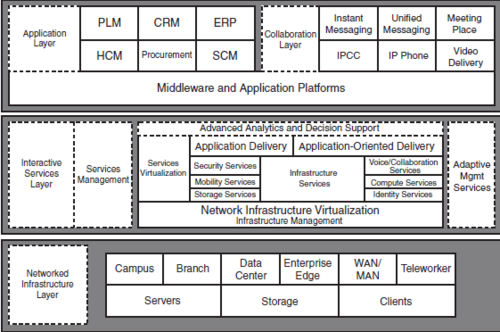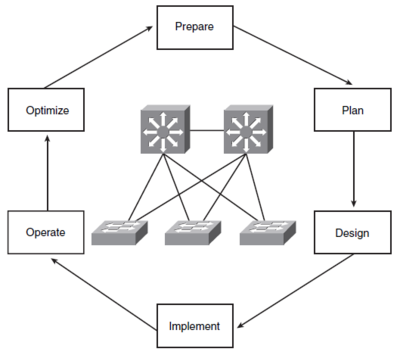CCDA/Network design methodology
Contents
SONA
Network Infrastructure Layer
The Network Infrastructure layer contains the Enterprise Network Architecture, which includes the Enterprise Campus, Enterprise Branch, data center, Enterprise Edge, WAN and LAN, and teleworkers.
The Cisco Enterprise Architecture is covered in Chapter 2, Network Structure Models. Servers, storage networks, and end-user clients reside at this layer.
This layer contains switching and routing elements to enhance performance and capabilities, including reliability and security. The network infrastructure is built with redundancy to provide increased reliability. Security configurations are applied to the infrastructure to enforce security policies.
Interactive Service Layer
This layer supports essential applications and the Network Infrastructure layer. Standardized network foundation and virtualization are used to allow security and voice services to scale better.
A standardized network architecture can be duplicated and further copied to scale a network.
Services provided at this layer fall into two categories: Infrastructure Services and Application Networking Services.
Infrastructure Services
The six infrastructure services are essential in the operation and optimization of network services and applications:
- Identity services include authentication, authorization, and accounting (AAA); Network Admission Control (NAC); and Network-Based Application Recognition (NBAR).
- Mobility services allow network access regardless of the location. An example is VPN.
- Storage services improve storage of critical data. Critical data must be backed up and stored offsite to allow for business continuity and disaster recovery.
- Compute services improve computing resources enterprise-wide. High-end servers can be used for virtual machines to scale the amount of servers on the network.
- Security services deliver security for all network devices, servers, and users. These services include intrusion detection and prevention devices.
- Voice and collaboration services allow user collaboration through all network resources. Cisco’s MeetingPlace is an example of a collaboration application.
Aplication Layer
- PLM: Product Lifecycle Management
- CRM: Customer relation Management Applications
- ERP: Enterprise Resource Planning Applications
- HCM: Human Capital Mangement
- Procurement Applications
- SCM: Supplu Chain Management
Collaboration applications include
- IM: Instant messaging
- UM: Unified Messaging
- IPCC: IP Contact Center
- Meeting Place
- Video delivery
PPDIOO
Prepare, Plan, Design, Implement, Operate and Optimize phases
Prepare Phase
The Prepare phase establishes organization and business requirements, develops a network strategy, and proposes a high-level architecture to support the strategy. Technologies that support the architecture are identified. This phase creates a business case to establish a financial justification for a network strategy.
Plan Phase
The Plan phase identifies the network requirements by characterizing and assessing the network, performing a gap analysis against best-practice architectures, and looking at the operational environment. A project plan is developed to manage the tasks, responsible parties, milestones, and resources to do the design and implementation. This project plan is followed during all phases of the cycle.
Design Phase
The network design is developed based on the technical and business requirements obtained from the previous phases. The network design provides high availability, reliability, security, scalability, and performance. The design includes network diagrams and an equipment list. The project plan is updated with more granular information for implementation. After the Design phase is approved, the Implement phase begins
Implement Phase
New equipment is installed and configured in the Implement phase. New devices replace or augment the existing infrastructure. The project plan is followed during this phase. Planned network changes should be communicated in change control meetings, with necessary approvals to proceed. Each step in the implementation should includes a description, detailed implementation guidelines, estimated time to implement, rollback steps in case of a failure, and any additional reference information. As changes are implemented they are also tested before moving to the Operate phase.
Operate Phase
The Operate phase maintains the network’s day-to-day operational health. Operations include managing and monitoring network components, routing maintenance, managing upgrades, managing performance, and identifying and correcting network faults. This phase is the design’s final test. During operation, network management stations should monitor the network’s general health and generate traps when certain thresholds are reached.
Optimize Phase
The Optimize phase involves proactive network management by identifying and resolving issues before they affect the network. The Optimize phase may create a modified network design if too many network problems arise, to improve performance issues, or to resolve application issues. The requirement for a modified network design leads to the network life cycle beginning.

